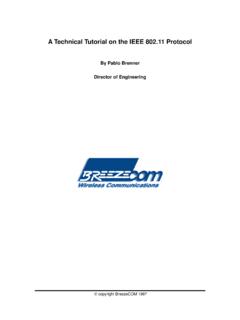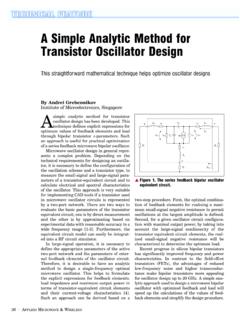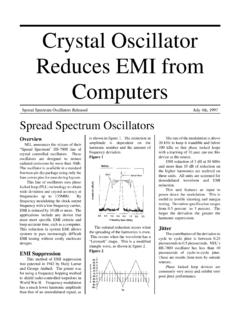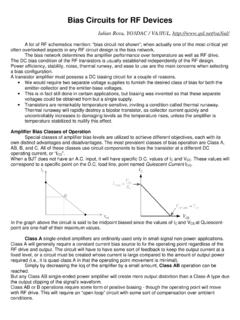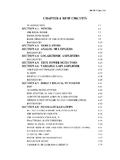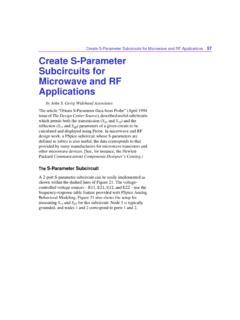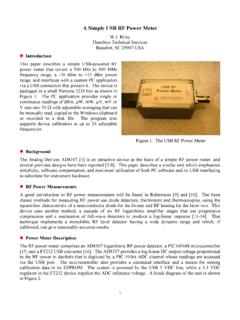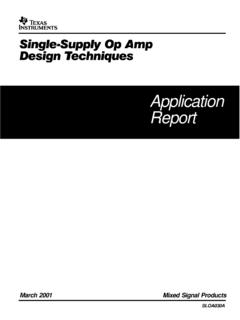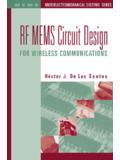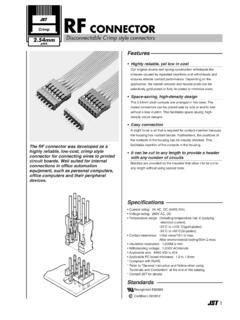Transcription of New Models Simulate RF Circuits - Spread spectrum
1 New Models Simulate RF Circuits Its no news to those who Simulate that the accuracy of SPICE is directly related to the accuracy of the Models . What may be news is that simulation of high frequency Circuits well into the gigahertz range is now possible due to the introduction of some new RF. SPICE Models . To illustrate the improved simulation accuracy, the RF Models were used to analyze a 500 MHz oscillator (Figure 1). The oscillator generates a relatively high power output with a very distorted output waveform (typical at power levels over the 1- 2mW range). The simulation goals were to study the start-up characteristics, oscillating frequency and amplitude, and the resulting harmonic distortion.
2 Two simulations were run. The first using the standard Gummel-Poon BJT model and simple inductor chokes and a second using an improved 2N5109 model along with a new Intusoft RF bead model from the RF Device Library. Above approximately 100-200 MHz, the built-in SPICE BJT. model , based on the Gummel Poon model , fails to accurately predict the real device performance. The BJT must be remodeled as a subcircuit (Table 1) in order to accurately model the package and bond wire parasitics which are of greater significance at higher frequencies. The improved model includes the package parasitics and matches the s-parameters up to 2 GHz.
3 The RF. library was created by Analog & RF Models , specialists in the creation of RF Models , for Intusoft [1]. LSP 170NH LB1, LB2, LS1, and LS2 are parasitic inductances for the capacitors. LBX, LCX, and 8 22. CG. V(3). RGC START LEX represent the additional 1 100PF 2 1K XLSP CB1 10PF lead inductance beyond the B9112 7 9 LB1. VCC RBU. 3NH plane where the manufac- R3 STARTUP V(7) CB2. VIN 8V VPOWER 47PF turer measured the transistor 1K PWL CIRCUITRY. LCX LB2 s-parameters. LEC and LSP. CCO 3NH. 12PF. LBX 5NH 6 are RF chokes. The varactor 3NH. 14 includes parasitic capaci- CBC 13.
4 11 X1 tance and inductance inside LS2 QN5109. 22PF. 3NH 16. the subcircuit. 5. 15 RBL LEC 170NH. 1K LEX. V(15) LS1 5NH. 12 3. RL VOUT 3NH. D1 V(3). 50 17 START 4 1 2 4 5. DN4148 3. R2 10E6. LT XLEC. 20NH CEX B9112. X2 VVT 5PF. DN5441 4V REX. RTI 10K. 18 30 47. VARACTOR. Figure 1, A 500 MHz oscillator and RF Bead (shaded area) test circuit . Page 1. Modeling An RF Bead Although SPICE does contain a model for a nonlinear inductor it does not have a built-in bead model . Fortunately, one can be created using the a nonlinear magnetics model and passive elements. The new model , as shown in Figures 1 & 2, accurately simulates the impedance vs.
5 Frequency response and the change in impedance vs. temperature. The change in impedance with DC. bias is also modeled due to the addition of the core model instead of a simple inductor. The bead model gives a very low DC. impedance while providing a large impedance at higher frequen- cies. The model used here is for a ferrite bead made of a medium permeability nickel zinc material from Fair-Rite, P#2743009112. Other types of beads including beads on leads, wound beads and surface mount beads can be found in the RF library [2]. 180 180. 1. 140 140. Z (2743003112) in Ohms Z (2743009112) in Ohms 2.
6 3. 4. 1 MEG 10 MEG 100 MEG 1G. Impedance (Ohms) vs. Frequency in Hz Figure 2, The Intusoft RF Bead model simulates the proper impedance vs. frequency characteristics. The graph displays the response for several devices. Starting An Oscillator Simulation of oscillators present a variety of challenges, not the least of which is getting the oscillator to oscillate. When ISSPICE. performs an AC or Transient analysis it first performs a DC. analysis in order to establish the starting initial operating point for the circuit . If a stable operating point is found, which is the goal of the DC analysis, the oscillator may not oscillate during the transient (time domain) analysis unless some random distur- bance is encountered.
7 There are a number of ways to start an oscillator; each with varying results and consequences (Figure 3). The method cho- sen here was to introduce a voltage pulse into the circuit , specifi- cally, at the emitter of the transistor (VIN 1 0 ). Another possible method is to insert a current pulse somewhere in the resonant portion of the circuit , for example at LT (I1 18 17 PULSE..01 0). If the DC analysis does not converge, a sign that the circuit Page 2. 1. Input Current Pulse At Time 0. 4. Input Voltage Pulse Ramping The Power Supply 2. UIC Transient Option 3. No Starting Help Given 5.
8 TIME in Secs Figure 3, Comparison of the various methods of thumping an oscillator to get it started show a current pulse at LT to be the most effective for this circuit . is unstable and may want to oscillate without any help, the UIC. keyword can be issued in the .TRAN statement. For example, .TRAN .1NS 50NS UIC. This will cause the simulation to proceed directly to the Transient analysis bypassing the DC analysis. The .IC and IC= parameters can then be used to set initial transient conditions and unbalance the oscillator. One problem with using UIC is that no DC operating point will be produced inhibiting study of the circuit bias.
9 The last method is similar to the first and involves ramping of the power supply (VCC 8 0 PULSE 0 8V 0. 5NS). This method may not work well, however, due to the bypass capacitors. In general, when ramping a source, make sure to give the ramp a realistic slope in order to avoid timestep too small . errors. The first two methods are the most often recommended as the other methods may not work or may introduce transient start- up residues [3]. circuit Modeling The oscillator circuit was first simulated with two inductor chokes, LSP and LEC (Figure 1), and a standard . model statement for the 2N5109 transistor.
10 In SPICE, the standard representation for a transistor uses the Gummel-Poon model . Various parameters in the SPICE . model statement are altered in order to cause the generic nature of the Gummel-Poon template to represent a particular device. In a second simulation, the chokes were each replaced with the new RF bead model . The simple transistor model was replaced with a subcircuit representation. Since the Gummel-Poon model can not adequately represent BJT behavior above approximately 200 MegHz, a composite model must be assembled. The SPICE. subcircuit, containing a BJT model and various parasitic ele- ments, is utilized for this purpose.



